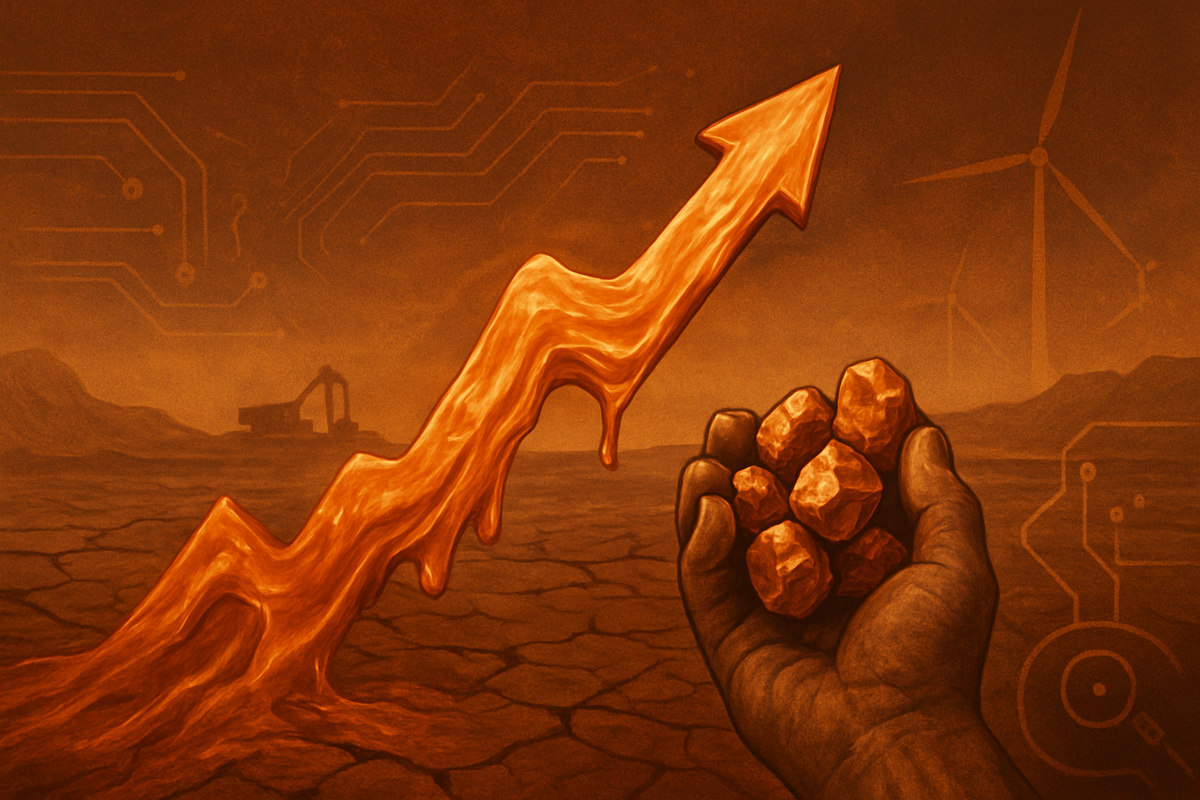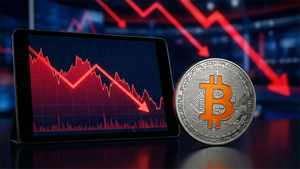
London's commodity markets are abuzz as copper prices have surged to an unprecedented high, with the benchmark London Metal Exchange (LME) copper reaching an astonishing $11,146 per metric ton on Wednesday, October 29, 2025. This remarkable rally, which has seen the industrial metal deliver its best performance since 2017, marks a significant turning point for global industries. The surge is primarily fueled by a potent combination of acute supply shortages, dwindling inventories, and a robust, forward-looking demand outlook, signaling potential inflationary pressures and a re-evaluation of supply chain strategies across various sectors.
The immediate implications are far-reaching, from increased production costs for manufacturers to a heightened focus on securing new supply sources for the burgeoning green energy transition. With analysts forecasting even higher prices in the near future and projecting significant market deficits, the copper market is not just experiencing a temporary spike but a fundamental shift that could redefine its economics for years to come.
Detailed Coverage: The Perfect Storm of Supply Disruptions and Soaring Demand
The journey to these record-breaking prices has been paved by a confluence of disruptive events and evolving market dynamics throughout 2025. A series of significant operational setbacks at some of the world's largest copper mines has been a primary catalyst. For instance, Freeport-McMoRan (NYSE: FCX)'s colossal Grasberg mine in Indonesia faced a critical suspension of operations due to a fatal mudslide, leading to a projected material reduction in its 2025 and 2026 output. Similarly, Ivanhoe Mines (TSX: IVN)'s Kamoa-Kakula operation in the Democratic Republic of Congo experienced a seismic event, forcing a downward revision of its 2025 guidance and the withdrawal of its 2026 forecasts. Even Chile's state-owned Codelco, a titan in copper production, reported its worst monthly output in two decades from its El Teniente mine in August, grappling with persistent operational challenges. These disruptions, alongside other unforeseen issues in Africa and Chile, have pushed global mine disruptions in 2025 to 6% of total supply, exceeding the historical average of 5%.
Adding to the supply woes, major mining houses have issued concerning production forecasts. London-listed Glencore (LSE: GLEN) reported a substantial 17% decline in copper production during the first nine months of 2025, subsequently lowering the upper limit of its full-year forecast. Anglo American (LSE: AAL) echoed similar sentiments, announcing a 9% drop in its copper output for the same period and cautioning that production from its flagship Collahuasi mine in Chile would likely be lower than anticipated next year. Teck Resources Ltd. (TSX: TECK) has also signaled potential reductions in its 2026 production. These collective shortfalls have led to a consensus among analysts, with the International Copper Study Group (ICSG) revising its 2025 mine supply growth forecast downwards and now projecting a 150,000-metric ton deficit in the refined copper market for 2026, a stark reversal from previous surplus predictions. Morgan Stanley has gone further, predicting that the global copper market is headed for its most severe deficit in over 20 years by 2026.
Beyond the immediate supply crunch, broader macroeconomic factors have amplified copper's ascent. Optimism surrounding an imminent trade deal between the US and China, with Presidents Donald Trump and Xi Jinping reportedly close to finalizing an agreement, has buoyed market sentiment, signaling potentially increased demand from the world's two largest economies. Concurrently, a weaker US dollar, which has depreciated over 7% since January and is expected to decline further amid anticipated Federal Reserve interest rate cuts, has made dollar-denominated commodities like copper more attractive to international buyers. Physical copper stocks at LME-registered warehouses have plummeted to their lowest levels since late July, underscoring the immediate tightness in the physical market.
The initial market reaction has been overwhelmingly bullish. Citigroup, among other financial institutions, has revised its price forecasts upwards, now predicting copper to reach $12,000 a ton in the first half of 2026. This fervent optimism reflects a widespread belief that the current supply-demand imbalance is not transitory but indicative of a structural shift, prompting industries reliant on copper to brace for sustained higher input costs and to actively explore hedging strategies and alternative material sourcing.
Winners and Losers in a High-Stakes Copper Market
The unprecedented surge in copper prices is creating a stark dichotomy across global industries, carving out clear winners and losers in this high-stakes market. For the copper mining and exploration companies, these elevated prices translate directly into significantly bolstered revenues and enhanced profitability. Giants like Chile's state-owned Codelco, the world's largest copper producer, stand to gain immensely, despite occasional operational challenges. Freeport-McMoRan (NYSE: FCX), a major player with extensive operations, has already seen its third-quarter 2025 results positively impacted by the high copper and gold prices, underscoring the direct benefit to its earnings. Similarly, global mining powerhouse Glencore (LSE: GLEN) reported a substantial 36% surge in its copper production in Q3 2025, perfectly positioned to capitalize on the record prices. Other major producers such as BHP Group (ASX: BHP) and Southern Copper Corporation (NYSE: SCCO) are also experiencing significant advantages from the current pricing environment. In India, Hindustan Copper (NSE: HINDCOPPER) has seen its share price climb, emerging as a top performer in the metals sector. Even smaller players like Amerigo Resources (TSX: ARG) have more than doubled their profits in the last quarter of 2025, driven by stronger copper pricing. First Quantum Minerals (TSX: FM) also reported strong Q3 2025 financial results, benefiting from higher realized metal prices. Beyond extraction, the high cost of newly mined copper also makes copper recycling a more economically attractive proposition, benefiting industries involved in reprocessing the metal.
Conversely, industries heavily reliant on copper as a primary raw material are facing considerable headwinds, grappling with escalating input costs that threaten to squeeze profit margins or necessitate price increases for consumers. Cable and wire manufacturers are particularly vulnerable, given that copper can constitute anywhere from 62% to 85% of their total raw material expenses. Indian companies such as Polycab India (NSE: POLYCAB), Finolex Cables (NSE: FINCABLES), KEI Industries (NSE: KEI), and RR Kabel (NSE: RRKABEL) are feeling the pressure, potentially resorting to hedging strategies or exploring substitutes like aluminum, though these often provide only partial mitigation.
The rapidly expanding Electric Vehicle (EV) sector is another significant casualty. EVs, with their intricate batteries, powerful motors, and extensive charging infrastructure, are inherently copper-intensive. Higher copper prices directly inflate manufacturing costs for companies like Tesla (NASDAQ: TSLA) and Rivian (NASDAQ: RIVN), potentially impacting their profitability and the affordability of their vehicles. Similarly, renewable energy infrastructure developers face increased costs for projects such as solar farms and wind installations, which require vast quantities of copper for wiring and grid connections. Electronics companies, including giants like Apple (NASDAQ: AAPL), will see their manufacturing costs rise for circuit boards, wiring, and other components. The construction industry, which uses copper extensively for electrical wiring, plumbing, and HVAC systems, will also contend with higher material costs, potentially affecting project viability and housing starts. Even the semiconductor industry, particularly in chip packaging, could see margins eroded if long-term contracts prevent the immediate passing on of increased copper costs. Furthermore, economies and manufacturers highly dependent on imported copper, such as the United States and Germany, face the dual challenge of elevated global prices and potential trade tariffs, risking higher inflation and even "demand destruction" as manufacturers scale back production due to unsustainable input costs.
Wider Significance: A New Era for the Industrial Metal
The current record-breaking copper prices in October 2025 are not merely a market anomaly but signify a profound shift with wide-ranging implications across industries and economies. Often dubbed "Doctor Copper" for its perceived ability to predict economic health, the metal's ascent to $11,146 per metric ton on the LME underscores a critical juncture where robust, future-oriented demand is colliding with entrenched supply constraints and evolving geopolitical landscapes.
This trend profoundly impacts several key sectors. The construction industry, a perennial consumer of copper for electrical wiring, plumbing, and HVAC systems, faces escalating material costs that could lead to budget overruns, project delays, or even cancellations. This volatility forces contractors to adopt more sophisticated risk management strategies and explore alternative materials like aluminum for specific applications. Similarly, the burgeoning Electric Vehicle (EV) manufacturing sector, which requires significantly more copper per unit than traditional internal combustion engine vehicles, will see higher production costs. This could either squeeze manufacturers' margins or lead to increased EV prices, potentially slowing the pace of adoption, especially among price-sensitive consumers. Crucially, the global transition to renewable energy and modern grid infrastructure relies heavily on copper for solar panels, wind turbines, power cables, and energy storage systems. While the demand from this transition is a primary driver of copper's rally, sustained high prices and potential shortages could paradoxically impede the very energy transition they are meant to facilitate, hindering carbon-reduction targets. The electronics and general manufacturing sectors also face increased input costs, which will likely be passed on to consumers or impact corporate profitability.
The ripple effects extend further, contributing to inflationary pressures across the broader economy. For resource-dependent nations, particularly in Latin America, copper revenue significantly influences national budgets and employment. The ongoing supply disruptions at major mines globally are intensifying supply chain vulnerabilities, risking shortages for manufacturers and impacting production schedules. This environment is also catalyzing investment shifts, drawing substantial capital into copper-focused funds and mining companies, as investors anticipate a "structural bull market" for the metal. Such investment is crucial to incentivize new mining projects and expand production to meet surging demand. From a geopolitical standpoint, copper's strategic importance is amplified; political instability in major producing regions can cause price volatility, and trade policies, such as tariffs, can distort global copper flows and create regional price disparities.
Governments and regulatory bodies are actively responding to this volatile market. In mid-2025, the US administration, citing national security, imposed a 50% tariff on certain semi-processed copper imports under Section 232 of the Trade Expansion Act. While refined cathode copper was temporarily exempted, future tariffs of 15% and 30% are slated for 2027 and 2028, respectively. These policies, aimed at bolstering domestic manufacturing, risk weakening US industry competitiveness and straining international trade relations. Concurrently, the US administration granted a two-year exemption from stringent Biden-era emissions standards for copper smelters in late 2025, signaling a prioritization of industrial continuity and domestic processing capacity. This move highlights the delicate balance between environmental protection and securing critical mineral supply. There is also growing pressure on regulatory bodies to streamline permitting processes for new mining projects to accelerate supply, albeit with continued scrutiny of environmental impacts.
Historically, copper has experienced several "supercycles" of sustained high demand and price rallies, often linked to periods of significant industrialization, such as early 20th-century US industrialization and China's economic boom in the early 2000s. Wartime demand, as seen during World War I and II, also triggered significant price surges, sometimes leading to government-imposed price controls. Supply constraints from underinvestment, labor issues, and geopolitical factors have consistently driven price spikes throughout history. The current scenario, combining robust demand from the green energy transition with persistent supply challenges and strategic geopolitical considerations, suggests that today's high copper prices may not be an aberration but rather a "new normal," essential to incentivize the massive supply required for a decarbonized global future.
What Comes Next: Navigating Copper's Future Trajectory
The current record highs in copper prices set in October 2025 herald a period of significant strategic recalibration for industries worldwide. While the short-term outlook presents a complex interplay of immediate market forces, the long-term trajectory for "Doctor Copper" appears set for sustained elevation, driven by an unyielding demand for global decarbonization and technological advancement.
In the short-term (next 6-12 months), copper prices are expected to remain robust, albeit with some volatility. Key drivers include ongoing supply disruptions from major mines globally, such as Ivanhoe Mines' (TSX: IVN) Kamoa-Kakula and Freeport-McMoRan's (NYSE: FCX) Grasberg, which have led to a projected contraction in global annual copper production for the first time since the pandemic. Optimism surrounding a potential US-China trade agreement is also bolstering market sentiment, while a weakening US dollar, driven by anticipated Federal Reserve interest rate cuts, makes dollar-denominated copper more attractive. Strategic demand from electrification, grid modernization, artificial intelligence (AI) data centers, and defense spending continues to accelerate. However, headwinds exist, including the US's 50% tariff on certain imported copper products (with refined cathode temporarily exempted, but future tariffs planned), which led to front-loaded imports and could trigger a destocking cycle. A slowdown in Chinese housing completions and reduced demand for white goods also temper demand from the world's largest consumer. Despite these, analysts like Citigroup project prices could hit $12,000 a ton in the first half of 2026, with UBS expecting $11,000 per metric ton by September 2026.
Looking at the long-term (beyond 1-2 years), the outlook for copper is overwhelmingly bullish, underpinned by structural supply deficits and surging demand. The global energy transition is the primary catalyst, with copper critical for renewable energy (solar, wind), electric vehicles (EVs) and their charging infrastructure, and extensive grid modernization. This sector is projected to account for 61% of global copper demand by 2040. Complementing this, digitalization and AI, requiring vast amounts of copper for 5G base stations and data centers, along with ongoing urbanization and infrastructure development, will sustain and grow demand. These demand drivers are set to collide with persistent supply constraints: depleting ore grades in existing mines, the lengthy 7-10 year (or even longer) development timelines for new projects, a decade of underinvestment in new exploration, and ongoing geopolitical risks in top-producing regions. Consequently, analysts project widening deficits, with Morgan Stanley predicting the most severe global copper deficit in over 20 years by 2026, and Goldman Sachs forecasting an 8.9 million-ton deficit by 2030. Many anticipate sustained high prices, potentially reaching US$15,000 a metric ton in the next two years, with new mines often requiring prices above $10,500 per ton to be profitable.
Strategic adaptations are becoming imperative for industries. EV manufacturers, facing an estimated $1,200 additional cost per vehicle due to higher copper prices, are exploring direct investments in mining companies to secure future supplies. Electronics and construction sectors are examining cost-pass-through strategies or seeking alternative materials. Manufacturers are diversifying supply chains and prioritizing domestic production or tariff-free alternatives, such as increased copper recycling. For mining companies, the focus is on extending the lifespan of existing, high-grade assets, engaging in mergers and acquisitions (M&A) to secure reserves, and leveraging technological innovation for improved ore recovery and exploration. Governments and policymakers are recognizing copper's strategic importance, with discussions around designating it a critical mineral to streamline permitting and provide federal funding for domestic projects.
Market opportunities abound for producers who can maintain or increase output, as well as for technology providers offering sustainable mining solutions, advanced material development, and efficient recycling processes. Investors may find tactical entry points in copper equities and LME-focused ETFs. However, challenges persist: the fundamental issue of supply shortages, the burden of higher manufacturing costs, geopolitical risks from trade policies and resource nationalism, and the potential for "demand destruction" if prices force industries to substitute away from copper. Environmental and social scrutiny on new mining projects also remains a significant hurdle.
Considering these dynamics, several potential scenarios could unfold. A sustained "supercycle" (bullish) could see copper prices normalize around $11,000-$11,800/ton, or even reach $15,000/ton, driven by persistent supply issues and accelerated green technology adoption. A gradual stabilization (base case) might see prices settle in the $9,500-$10,500/ton range as some new supply slowly comes online. Conversely, a demand deceleration/macroeconomic downturn (bearish) scenario, possibly due to a global recession or severe slowdown in China, could push prices lower. Lastly, a fragmented market could emerge due to US tariffs, leading to divergent prices and trade flows between the US and the rest of the world. Ultimately, copper's role as the "metal of the future" for the energy transition ensures its long-term strategic importance, with elevated prices likely to be a defining feature of the coming decade.
Wrap-Up: Copper's Enduring Role in a Decarbonizing World
The record-shattering copper prices witnessed in London in October 2025 mark a pivotal moment for the global financial markets and industrial sectors. The confluence of persistent supply challenges, burgeoning demand from the global energy transition, and supportive macroeconomic conditions has created a "perfect storm" that has pushed the industrial metal to unprecedented highs of $11,146 per metric ton on the LME. This is not merely a transient spike but signals a fundamental, structural shift in the copper market, redefining its economics for the foreseeable future.
The market assessment points unequivocally to a deepening deficit. Major mining companies, including Glencore (LSE: GLEN), Anglo American (LSE: AAL), Freeport-McMoRan (NYSE: FCX), and Ivanhoe Mines (TSX: IVN), have reported significant production declines and operational setbacks throughout 2025. These disruptions, coupled with robust demand from electrification, electric vehicles, renewable energy infrastructure, and the rapidly expanding needs of artificial intelligence data centers, are creating a tangible physical tightness. Analysts from Jefferies, the International Copper Study Group (ICSG), and Morgan Stanley all concur, forecasting "sizeable deficits" in the coming years, with Morgan Stanley predicting the most severe deficit in over two decades for 2026. Inventory levels at LME-registered warehouses, at their lowest since late July, further underscore this immediate supply crunch.
The lasting impact of this rally is a structural shift towards a new era of higher copper prices. The demand drivers for copper are not cyclical but secular, deeply embedded in the global imperative to decarbonize. BHP Group (ASX: BHP) forecasts a staggering 70% increase in global copper demand by 2050, primarily driven by the energy transition. Copper's irreplaceable role in the green economy ensures that sustained high prices will likely become the "new normal," necessary to incentivize the massive investment required to bring new supply online and meet this burgeoning demand.
For investors, vigilance remains key in a market poised for continued volatility. Several factors warrant close attention in the coming months: the evolving US-China trade relations, particularly any outcomes from anticipated high-level meetings, will significantly influence market sentiment and industrial demand. The Federal Reserve's monetary policy, with further interest rate decisions potentially impacting the US dollar and broader economic activity, will also be critical. Continuous monitoring of mine production updates from major producers globally will provide crucial insights into the real-time supply picture. Lastly, keeping an eye on global economic indicators and copper inventory levels at major exchanges will offer a pulse on the physical market's tightness. With significant deficits projected and strong underlying demand drivers, copper stands as a critical commodity to watch, offering both opportunities and challenges for those navigating the evolving landscape of global finance and industry.
This content is intended for informational purposes only and is not financial advice




